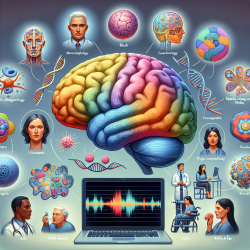Introduction
Early-Onset Alzheimer’s Disease (EOAD) presents a unique challenge to practitioners due to its clinical heterogeneity and the complexity of its diagnosis. A recent study titled "Dissecting the clinical heterogeneity of early-onset Alzheimer’s disease" provides insights into the diverse clinical presentations of EOAD and highlights the importance of integrating biomarkers, neuroimaging, and genetic analysis to enhance diagnostic accuracy and understanding of this condition.
Clinical Heterogeneity in EOAD
EOAD is characterized by a wide range of clinical syndromes, including typical amnestic phenotypes and atypical variants that affect visuospatial, language, executive, behavioral, and motor functions. This diversity often leads to misdiagnosis and delays in treatment, underscoring the need for practitioners to be aware of these variations.
Advancements in Biomarker Research
The study emphasizes the role of fluid biomarkers in improving EOAD diagnosis. Measurements of amyloid-beta, total tau, and phosphorylated tau in cerebrospinal fluid and plasma have shown promise in distinguishing EOAD from other neurodegenerative diseases. Practitioners should consider incorporating these biomarkers into their diagnostic toolkit to enhance precision.
Neuroimaging Techniques
Neuroimaging, particularly amyloid-PET and tau-PET, provides valuable insights into the neuropathological changes associated with EOAD. These imaging techniques can detect amyloid and tau deposits in living patients, offering a non-invasive method to monitor disease progression and tailor interventions accordingly.
Genetic Insights
Genetic variations play a significant role in EOAD, with certain pathogenic variants in genes such as APP, PSEN1, and PSEN2 being implicated. Understanding these genetic factors can help practitioners identify at-risk individuals and provide targeted interventions. The study also highlights the potential of emerging genetic analyses to uncover additional risk factors.
Implications for Practitioners
For practitioners, the integration of biomarkers, neuroimaging, and genetic analysis offers a comprehensive approach to diagnosing and managing EOAD. By staying informed about the latest research developments, practitioners can improve their diagnostic accuracy and provide more personalized care to patients.
Encouraging Further Research
While significant progress has been made, there is still much to learn about EOAD. Practitioners are encouraged to engage in further research and collaborate with multidisciplinary teams to explore new diagnostic and therapeutic avenues. By contributing to the growing body of knowledge, practitioners can play a crucial role in advancing the understanding and treatment of EOAD.
To read the original research paper, please follow this link: Dissecting the clinical heterogeneity of early-onset Alzheimer’s disease.










